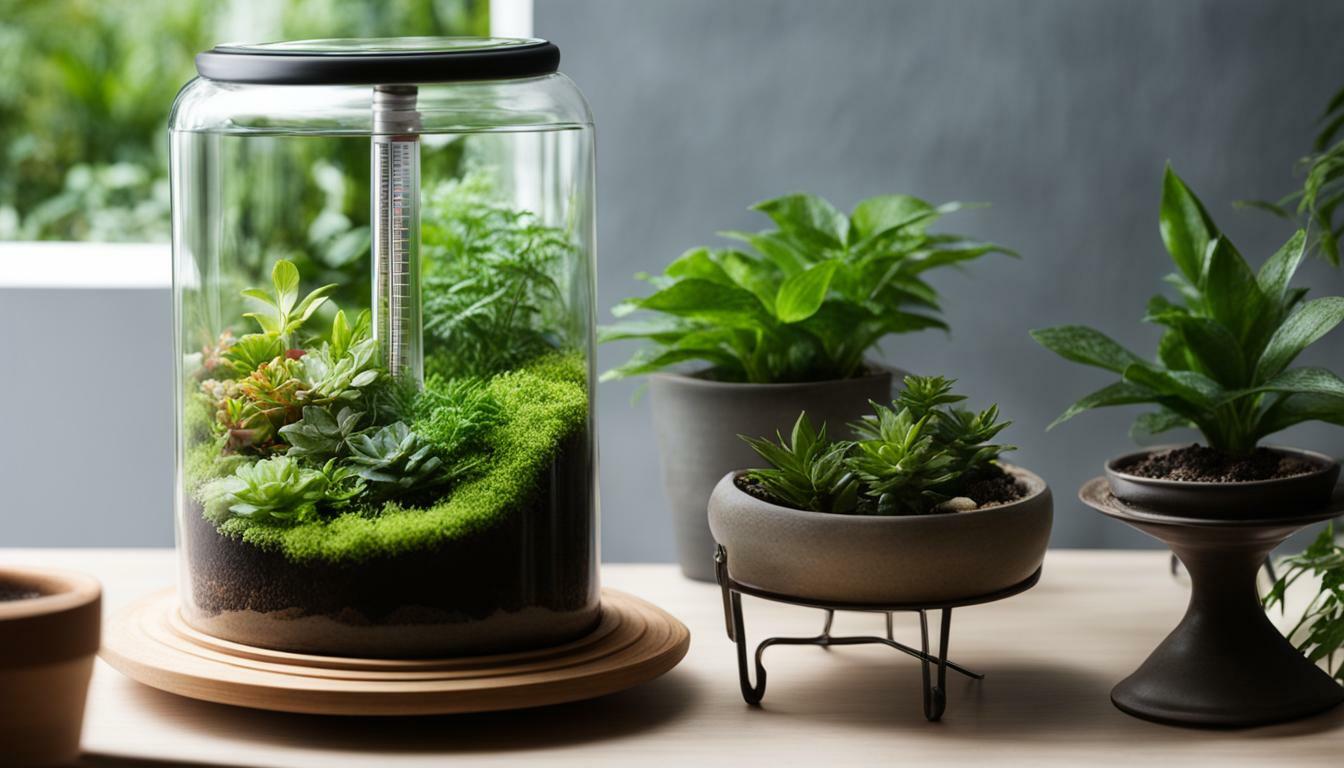Temperature regulation is a crucial aspect of terrarium care to ensure the optimal conditions for your plant sanctuary. Terrariums are miniature ecosystems enclosed in glass containers, and proper care is essential for their longevity. Maintaining the ideal temperature is crucial for the health and longevity of your terrarium.
Direct sunlight should be avoided as it can cause the temperature inside the terrarium to rise quickly and potentially harm the plants. Instead, terrariums should be placed in an area with indirect light or supplemented with grow lights or fluorescent lights. Heat sources such as radiators should also be avoided as they can kill terrarium plants.
Keeping the terrarium clean is important to allow light to reach the plants, and occasional cleaning of the glass with a damp cloth is recommended. Over-watering should be prevented, and a spray bottle can be used instead of a watering can. Terrarium plants do not typically require fertilization, and selecting plants that can thrive in the humid environment of a terrarium is crucial.
Plants that prefer moist conditions and low to medium light levels are ideal, while succulents should be grown in open containers. During the settling-in period, terrariums may experience issues such as mold, fungus, and pests, which should be dealt with promptly. With proper temperature regulation and care, terrariums can thrive and last for several years.
- Avoid direct sunlight and heat sources to maintain the ideal temperature in your terrarium.
- Ensure proper placement of your terrarium in an area with indirect light or supplemented with grow lights.
- Keep your terrarium clean to allow light to reach the plants and prevent potential issues like mold and fungus.
- Proper watering techniques and selecting plants that thrive in a humid environment are essential for terrarium care.
- Succulents should be grown in open containers with different temperature requirements compared to other terrarium plants.
Understanding Terrarium Temperature Control Methods
There are several effective techniques you can utilize to regulate the temperature inside your terrarium. Proper temperature control is vital for maintaining a healthy environment for your plants. By implementing these methods, you can ensure that your terrarium thrives and remains a vibrant miniature ecosystem.
1. Placement: The placement of your terrarium plays a crucial role in temperature regulation. Avoid direct sunlight, as it can cause the temperature inside the terrarium to rise quickly and potentially harm the plants. Instead, choose an area with indirect light or consider supplementing with grow lights or fluorescent lights to provide the necessary illumination.
2. Heat Source Avoidance: In addition to sunlight, it is important to keep your terrarium away from heat sources such as radiators. Excessive heat can be detrimental to terrarium plants, even causing them to wither and die. By keeping your terrarium in a cool area, you can prevent unnecessary damage.
3. Cleanliness: Maintaining cleanliness is essential for optimal temperature regulation. Clean the glass walls of your terrarium periodically using a damp cloth. By removing any dust or grime, you allow more light to reach the plants, enhancing their overall health and growth.
4. Watering and Plant Selection: Proper watering techniques are crucial for temperature maintenance. Avoid over-watering by using a spray bottle instead of a watering can. Additionally, select plants that can thrive in the humid environment of a terrarium. Look for species that prefer moist conditions and low to medium light levels.
By following these temperature control methods, you can create an ideal environment for your terrarium plants to flourish. Remember to monitor the temperature regularly and make adjustments as needed to ensure the long-term success of your miniature ecosystem.
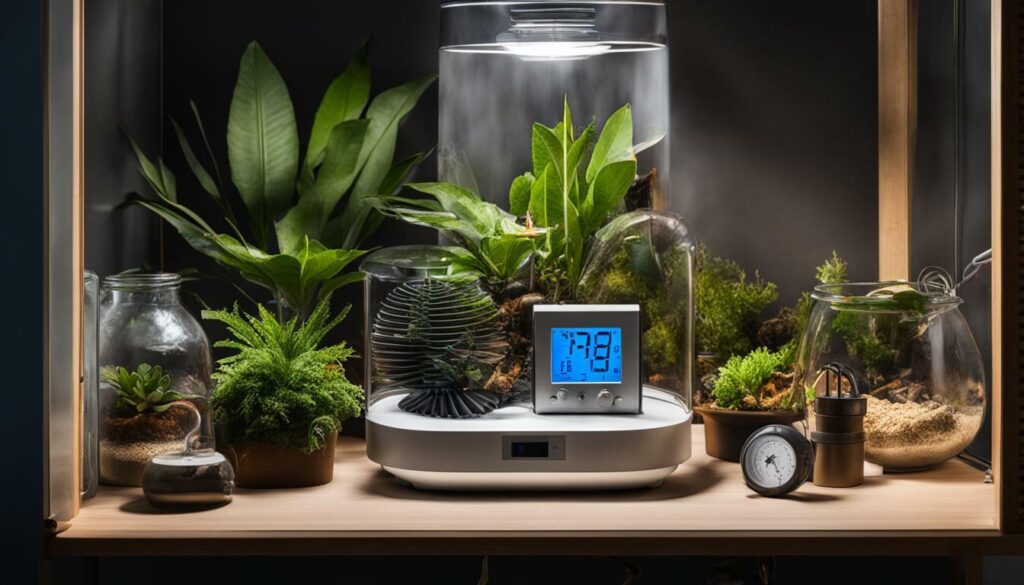
| Time | Temperature | Action |
|---|---|---|
| 8:00 AM | 22°C | Check temperature and adjust lighting if required |
| 10:00 AM | 24°C | Monitor temperature and ensure proper airflow |
| 1:00 PM | 25°C | Mist plants with water to maintain humidity |
| 4:00 PM | 23°C | Check temperature and adjust lighting if required |
| 7:00 PM | 21°C | Monitor temperature and adjust placement if necessary |
Placing Your Terrarium for Ideal Temperature
Finding the ideal location for your terrarium is crucial in maintaining the optimal temperature. The temperature inside your terrarium can greatly impact the health and growth of the plants within. To ensure the best conditions for your terrarium, it is important to consider the following factors:
- Light exposure: Terrariums should be placed in an area with indirect light. Direct sunlight can cause the temperature inside the terrarium to rise quickly and harm the plants. If you are unable to provide sufficient indirect light, consider supplementing with grow lights or fluorescent lights.
- Avoid heat sources: Heat sources such as radiators or heating vents should be kept away from your terrarium. These sources can generate excessive heat that can be harmful to terrarium plants, leading to their demise. It’s best to keep your terrarium in a cool area away from direct heat.
“Terrariums should be placed in an area with indirect light.”
Keeping your terrarium clean is also important in maintaining the ideal temperature. A clean terrarium allows light to reach the plants and promotes proper air circulation. Occasional cleaning of the glass with a damp cloth will help remove any dust or debris that may hinder light penetration.
When it comes to watering, be careful not to over-water your terrarium. Over-watering can lead to excessive moisture and high humidity levels, affecting the temperature inside. Instead, use a spray bottle to mist the plants lightly, avoiding waterlogging the soil. The goal is to maintain a moist environment without creating stagnant water.
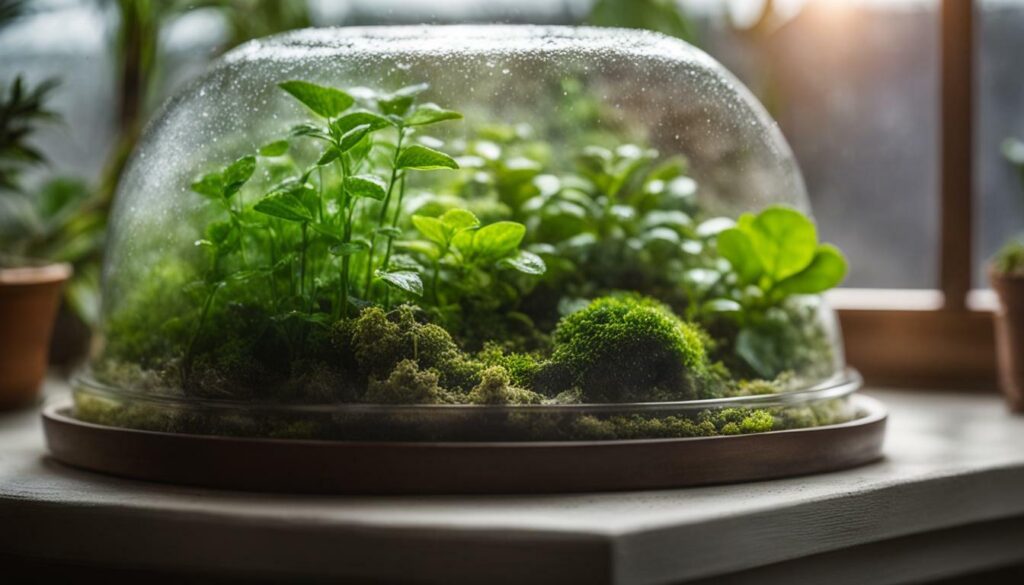
Choosing the right plants for your terrarium is essential for temperature regulation. Opt for plants that thrive in humid environments and prefer low to medium light levels. Such plants are well-suited for the conditions found inside a terrarium and will help maintain the desired temperature.
Summary
To regulate the temperature in your terrarium effectively, proper placement is crucial. Avoid direct sunlight and heat sources, select suitable plants that prefer moist conditions and low to medium light levels, and ensure regular cleaning to maintain optimal temperature and overall health. By following these guidelines, your terrarium will flourish and provide an enchanting display for years to come.
Avoiding Direct Sunlight and Heat Sources
Direct sunlight should be avoided as it can quickly raise the temperature inside the terrarium and potentially harm the plants. Terrariums are miniature ecosystems enclosed in glass containers, and temperature regulation is a crucial aspect of terrarium care. Excessive heat can cause stress to plants, leading to wilting, burnt leaves, and even death. To prevent these issues, it is recommended to place your terrarium in an area with indirect light or supplement it with grow lights or fluorescent lights.
Heat sources such as radiators should also be avoided as they can create hot spots within the terrarium, which may be lethal to the delicate plants. It’s important to maintain a stable and moderate temperature within the terrarium to ensure the well-being of the plants and the overall ecosystem. Proper temperature control methods can help create an environment that mimics the natural habitats of the plants, allowing them to thrive.
Along with temperature management, keeping the terrarium clean is vital. Regular cleaning of the glass with a damp cloth allows light to penetrate and reach the plants, supporting their growth. Over-watering should be prevented as it can lead to excess moisture and cause root rot. Instead, using a spray bottle to mist the plants lightly is recommended. Additionally, terrarium plants typically do not require fertilization, as the nutrients present in the soil and decaying plant materials are usually sufficient for their growth.
When selecting plants for your terrarium, it is crucial to choose those that can thrive in the humid environment typically found inside a terrarium. Plants that prefer moist conditions and low to medium light levels are ideal choices. Succulents, on the other hand, should be grown in open containers, as they have different temperature requirements compared to other terrarium plants. During the settling-in period of a terrarium, there may be challenges such as the development of mold, fungus, or pests. Timely intervention and proper care can help mitigate these issues and ensure the long-term success of your terrarium.
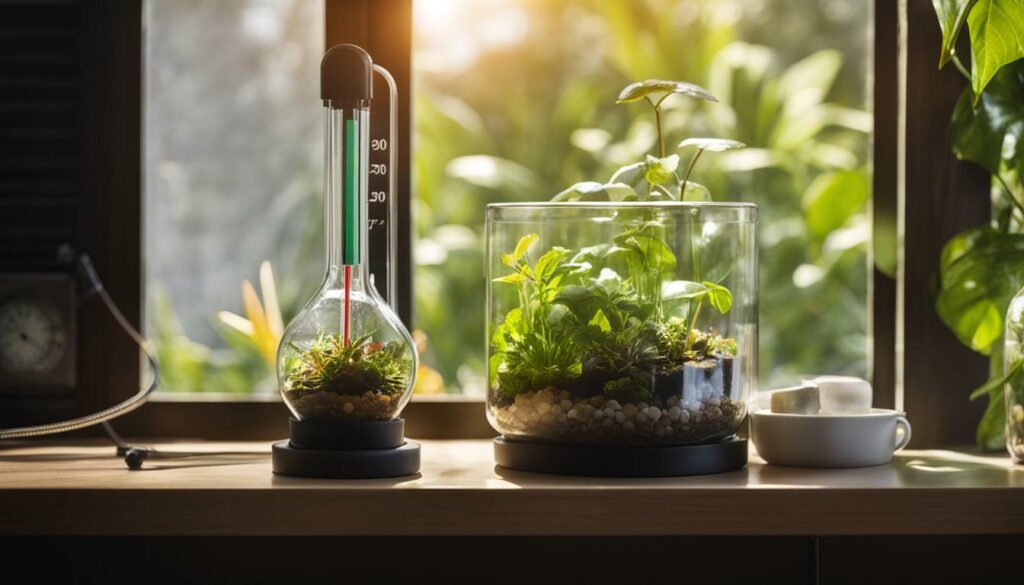
| Temperature Control Methods | Advantages |
|---|---|
| Indirect lighting or grow lights | Allows for a controlled temperature |
| Avoiding heat sources | Prevents overheating and damage to plants |
| Cleaning the terrarium | Allows light to reach plants effectively |
| Misting plants instead of over-watering | Avoids excess moisture and root rot |
| Selecting suitable plants | Ensures plants thrive in the terrarium environment |
| Proper care during settling-in period | Addresses mold, fungus, and pest issues promptly |
Maintaining Cleanliness for Better Temperature Regulation
Regular cleaning and maintenance of your terrarium are crucial for proper temperature regulation. By keeping your terrarium clean, you ensure that light can reach the plants and maintain an optimal temperature. Cleaning the glass of your terrarium with a damp cloth removes dust and debris that can block light and hinder temperature control.
In addition to cleaning the glass, it is important to regularly inspect and remove any dead or decaying plant matter. This not only helps with temperature regulation but also prevents the growth of mold and fungus, which can thrive in a damp terrarium environment. Removing any pests, such as spider mites or mealybugs, is equally important to maintain the health and temperature balance of your terrarium ecosystem.
To prevent over-watering, which can lead to temperature fluctuations and potentially harmful moisture levels, use a spray bottle to mist the plants rather than a watering can. This allows for precise and controlled watering, ensuring the terrarium stays within the optimal temperature range. Remember to monitor the moisture levels of the soil and adjust watering accordingly.
By maintaining cleanliness and performing regular upkeep, you can effectively regulate the temperature within your terrarium, providing a healthy and thriving environment for your plants.
| Key Points | Benefits |
|---|---|
| Regular cleaning and maintenance | Allows light to reach plants |
| Removing dead or decaying plant matter | Prevents mold and fungus growth |
| Eliminating pests | Maintains temperature balance |
| Using a spray bottle for watering | Prevents over-watering and temperature fluctuations |
“Cleaning and maintaining your terrarium is essential for keeping the temperature regulated and ensuring the health of your plants.”
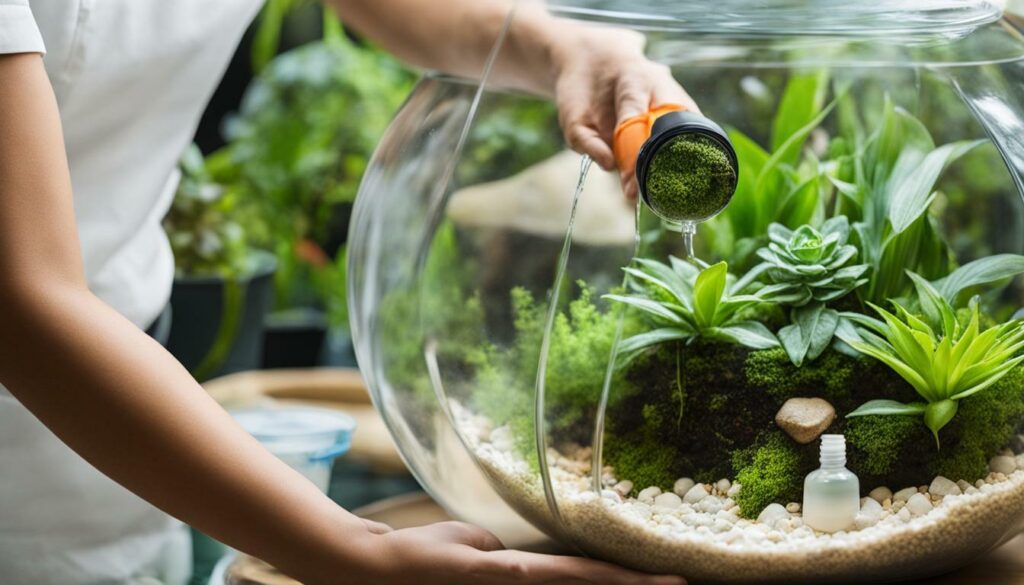
Proper Cleaning Techniques
When cleaning the glass of your terrarium, avoid using chemical cleaners or harsh substances as they may harm your plants. Instead, opt for a damp cloth or paper towel to gently wipe away any dirt or fingerprints. Be careful not to apply excessive pressure, as this can cause damage to the glass or disturb the arrangement of your terrarium.
For removing dead plant matter, use small pruning shears or scissors to carefully trim away any wilted leaves or stems. Be sure to dispose of the plant material properly to prevent the spread of disease or pests.
- Use a damp cloth or paper towel to clean the glass
- Avoid using harsh chemicals
- Trim dead plant matter with pruning shears or scissors
- Dispose of plant material properly
By following these cleaning techniques and incorporating regular maintenance, you can optimize the temperature regulation in your terrarium, promoting the longevity and vibrancy of your plant collection.
Watering and Fertilization Considerations
Proper watering and plant selection are essential aspects of maintaining the temperature in your terrarium. Over-watering can lead to high humidity levels, resulting in a rise in temperature that may be detrimental to the plants. Instead of using a watering can, it is recommended to use a spray bottle to lightly mist the terrarium. This method ensures that the plants receive the right amount of moisture without creating excess humidity. It is important to monitor the moisture levels in the soil and adjust the watering accordingly. Remember, each plant has different water requirements, so it is crucial to research and select plants that can thrive in the humid environment of a terrarium.
Fertilization is not typically necessary for terrarium plants, as they can derive nutrients from the ecosystem within the enclosed environment. The plants in your terrarium will naturally recycle nutrients and maintain their own balance. Adding fertilizer to the terrarium can disrupt this delicate equilibrium and lead to imbalances in temperature regulation. However, if you observe signs of nutrient deficiency, such as slow growth or yellowing leaves, you may consider using a diluted, water-soluble fertilizer specifically formulated for terrarium plants. Always follow the manufacturer’s instructions and avoid over-fertilizing, as it can cause more harm than good.
To summarize, remember to water your terrarium appropriately using a spray bottle and selecting plants that prefer moist conditions. Avoid over-watering to prevent excessive humidity and subsequent temperature fluctuations. Avoid using fertilizers unless necessary, as terrarium plants can extract nutrients from their self-sustaining ecosystem. By following these watering and fertilization considerations, you can maintain the optimal temperature within your terrarium, ensuring the health and longevity of your miniature ecosystem.
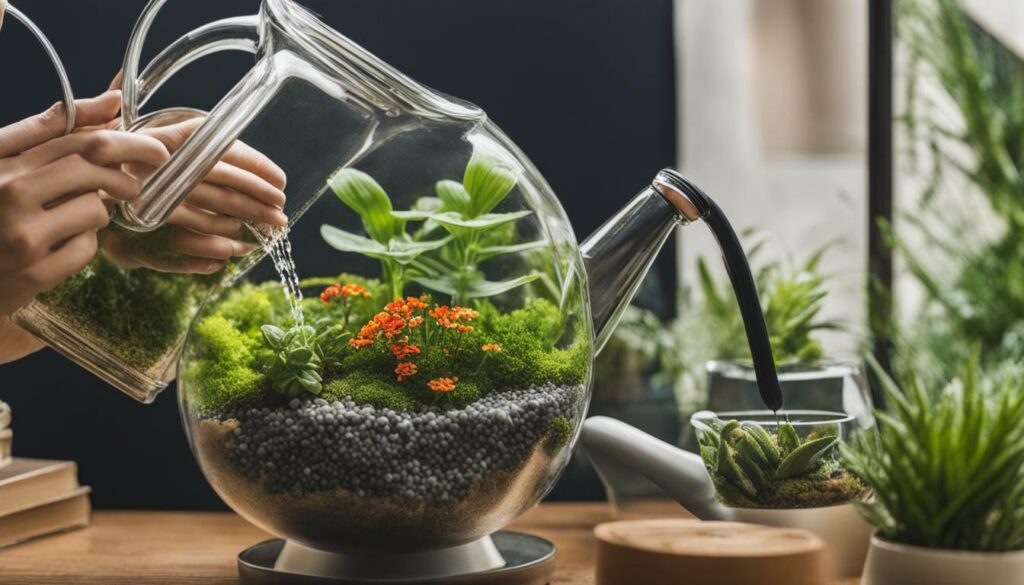
Settling-in Period Challenges
During the initial period, your terrarium may encounter challenges that can affect temperature regulation and plant health. It is important to be aware of these potential issues and take necessary steps to address them promptly. One common challenge is the development of mold or fungus, which can thrive in the humid environment of the terrarium. To prevent this, ensure proper air circulation and avoid over-watering. Additionally, regularly inspect and remove any decaying leaves or dead plant matter to reduce the risk of mold growth.
Pests such as aphids or mites may also appear during the settling-in period. These tiny insects can disrupt the temperature balance and harm the plants. To combat this, regularly inspect your terrarium for signs of pests and take appropriate measures to eliminate them. This may include using organic pesticides or introducing natural predators, such as ladybugs, to control the pest population.
Another challenge during the settling-in period is maintaining the ideal temperature. Fluctuations in temperature can stress the plants and hinder their growth. To ensure optimal temperature regulation, monitor the terrarium closely and make adjustments as needed. You can use a digital thermometer to keep track of the temperature inside the terrarium and position it in an area with consistent temperature levels. If necessary, consider using a small fan or opening the terrarium lid occasionally to regulate the temperature.
- Maintain proper air circulation to prevent mold and fungus growth
- Regularly inspect for pests and take appropriate measures to eliminate them
- Monitor and adjust the temperature as needed
- Remove decaying leaves or dead plant matter to reduce the risk of mold
In the words of terrarium expert Jane Doe, “The settling-in period of a terrarium is crucial for its long-term success. By addressing challenges promptly and maintaining the ideal temperature, you can create a thriving ecosystem.”
Summary:
During the settling-in period of your terrarium, it is important to be aware of challenges that can affect temperature regulation and plant health. Mold, fungus, and pests can arise in the humid environment of the terrarium, so proper air circulation and regular inspection are crucial. Additionally, maintaining the ideal temperature and removing decaying leaves or dead plant matter will contribute to the long-term success of your terrarium. By addressing these challenges promptly, you can create a thriving ecosystem that will bring joy and beauty to your space.
Selecting Suitable Plants for Terrariums
Choosing the right plants for your terrarium is vital in maintaining the optimal temperature and overall health of the ecosystem. Terrariums are delicate environments that require plants that can thrive in moist conditions and low to medium light levels. By carefully selecting the appropriate plant species, you can create a thriving and visually appealing terrarium.
Here are some plant options that are ideal for terrariums:
- Ferns: Ferns are popular choices for terrariums due to their love for humidity and shade. They come in various sizes and textures, adding a lush, tropical feel to your terrarium.
- Moss: Moss adds a beautiful touch of green to your terrarium, and it thrives in the moist and shady environment. It helps to retain moisture and provides a soft, carpet-like covering for the soil.
- Peperomia: Peperomia is a low-maintenance plant with glossy leaves and interesting patterns. They prefer indirect light and well-draining soil, making them an excellent choice for terrariums.
- Ficus Pumila: Also known as creeping fig, Ficus Pumila is a vine that can quickly cover the walls and floor of your terrarium. It enjoys high humidity and can tolerate low light conditions.
Remember to choose plants that have similar environmental requirements to ensure harmony within the terrarium. Grouping plants with similar humidity and light needs together will make it easier to maintain the temperature and overall well-being of your terrarium.
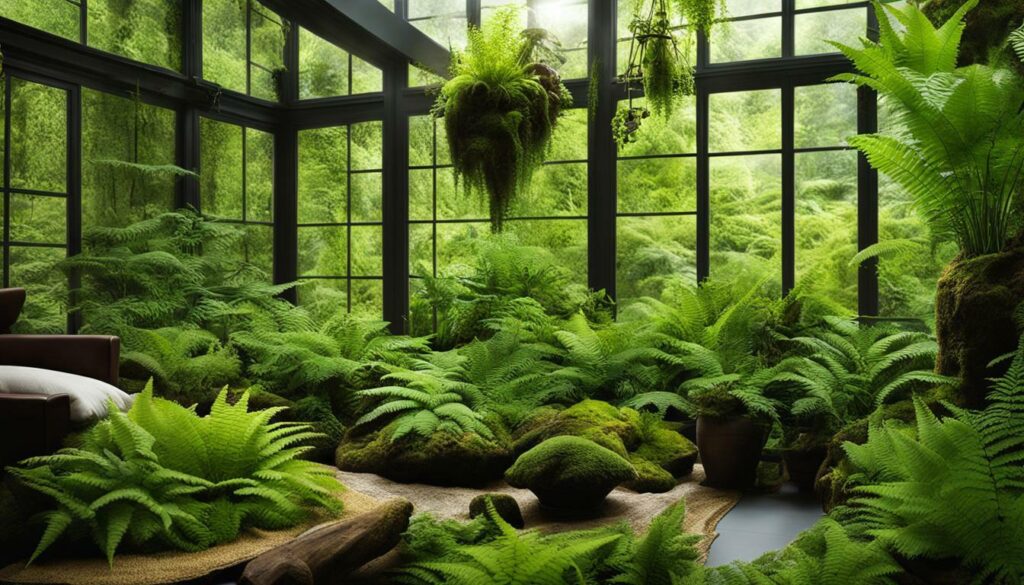
Creating a terrarium is an opportunity to showcase your creativity and design skills while providing a miniature ecosystem for your plants. By following these guidelines and selecting suitable plants, you can maintain the optimal temperature and create a beautiful and thriving terrarium that will bring joy and tranquility to your space.
Growing Succulents in Open Containers
If you plan to cultivate succulents in your terrarium, special considerations must be taken regarding temperature regulation. Succulents are known for their ability to thrive in arid environments, so it is crucial to provide them with the right conditions within your terrarium.
Succulents prefer higher temperatures compared to other terrarium plants, usually ranging between 70 to 80 degrees Fahrenheit (21 to 27 degrees Celsius). However, they also require a significant temperature drop at night, which mimics their natural habitat. Therefore, it’s important to maintain a day-night temperature cycle to promote their growth and overall health.
To achieve the ideal temperature conditions for your succulents, it’s recommended to place your terrarium in a location that receives bright, indirect sunlight for most of the day. South or west-facing windows are usually the best options. However, be mindful of direct sunlight, as it can cause overheating. If your succulents are exposed to too much direct sunlight, you can use a sheer curtain or shade cloth to filter the light and protect them from excessive heat.
In addition to proper sunlight exposure, it’s crucial to provide adequate airflow within your terrarium. Succulents thrive in well-ventilated environments, as stagnant air can lead to fungal issues and poor growth. Consider periodically opening the lid or adding a small fan to improve air circulation. This will help regulate the temperature and prevent overheating.
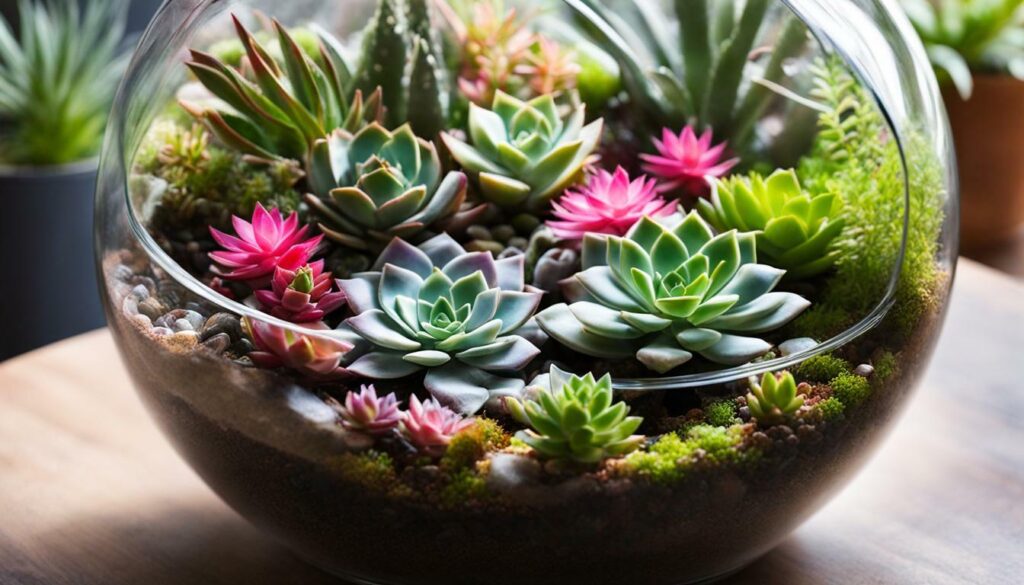
When it comes to watering succulents in an open terrarium, moderation is key. Overwatering is one of the most common mistakes that can lead to root rot and damage the plants. Succulents have adapted to survive in low-water environments by storing moisture in their leaves and stems. They prefer to dry out between waterings.
It is recommended to use a spray bottle to lightly mist the soil and leaves of your succulents every few days. This allows for controlled and minimal watering, preventing excess moisture. Another approach is to use a well-draining soil mix specifically designed for succulents. The soil should be allowed to dry out between watering sessions to maintain the proper balance of moisture in the terrarium.
By considering these temperature regulation tips, you can create an optimal environment for your succulents to thrive in an open terrarium. Remember, each succulent species may have slightly different temperature preferences, so it’s important to research and select plants that are suitable for your specific terrarium setup.
How Does Air Circulation Impact Temperature Regulation in Terrarium Care?
Proper air circulation tips for terrariums are crucial for maintaining the right temperature. Without adequate airflow, terrariums can become too hot or too cold, affecting the health of the plants and animals inside. By ensuring good air circulation, temperature regulation can be more effectively managed, creating a healthier environment overall.
Conclusion
Proper temperature regulation is essential for creating a thriving and long-lasting terrarium ecosystem. Terrariums are miniature ecosystems enclosed in glass containers, and maintaining the ideal temperature is crucial for the health and longevity of your terrarium.
One of the key factors in temperature regulation is avoiding direct sunlight. Sunlight can cause the temperature inside the terrarium to rise quickly, potentially harming the plants. Instead, place your terrarium in an area with indirect light or supplement it with grow lights or fluorescent lights.
In addition to sunlight, heat sources such as radiators should be avoided as they can kill terrarium plants. Keeping your terrarium clean is also important to allow light to reach the plants. Occasional cleaning of the glass with a damp cloth is recommended to remove any dust or dirt that may be blocking the light.
When it comes to watering, it’s important to prevent over-watering. Instead of using a watering can, a spray bottle can be used to provide a light misting. Terrarium plants typically do not require fertilization, but selecting plants that can thrive in the humid environment of a terrarium is crucial. Look for plants that prefer moist conditions and can tolerate low to medium light levels.
If you’re growing succulents in open containers, keep in mind that they have different temperature needs compared to other terrarium plants. Succulents prefer drier conditions and higher light levels, so make sure to provide them with the appropriate care and environment.
During the settling-in period of your terrarium, you may encounter issues such as mold, fungus, or pests. These should be dealt with promptly to ensure the health of your terrarium. Regular monitoring and proper care can help prevent and address these challenges.
In conclusion, with proper temperature regulation and care, your terrarium can thrive and last for several years. By following these temperature regulation essentials and implementing suitable terrarium care practices, you can create a beautiful and sustainable ecosystem that will bring joy and serenity to your space.
FAQ
Can direct sunlight harm my terrarium?
Yes, direct sunlight can cause the temperature inside the terrarium to rise quickly, potentially harming the plants. It is best to place your terrarium in an area with indirect light or supplement it with grow lights or fluorescent lights.
Should I avoid placing my terrarium near heat sources?
Yes, heat sources such as radiators should be avoided as they can kill terrarium plants. Maintaining a stable temperature is crucial for the health of your terrarium.
How should I clean my terrarium?
Keeping your terrarium clean is important to allow light to reach the plants. Use a damp cloth to periodically clean the glass and remove any dust or dirt.
How often should I water my terrarium?
Over-watering should be prevented in a terrarium. Instead of using a watering can, it is recommended to use a spray bottle to lightly mist the plants as needed.
Do terrarium plants require fertilization?
Terrarium plants do not typically require fertilization. They can extract the necessary nutrients from the soil and the enclosed ecosystem. However, it is important to select plants that can thrive in the humid environment of a terrarium.
What should I do if I encounter mold, fungus, or pests in my terrarium?
During the settling-in period of a terrarium, issues like mold, fungus, and pests may arise. It is important to address these promptly to prevent further damage. Consult with a terrarium care specialist or use appropriate treatments to eliminate these problems.
What kind of plants are best suited for terrariums?
Plants that prefer moist conditions and low to medium light levels are ideal for terrariums. They thrive in the enclosed, humid environment. However, succulents should be grown in open containers as they have different temperature needs compared to other terrarium plants.

